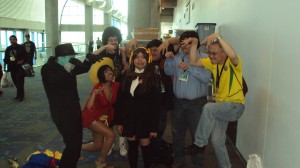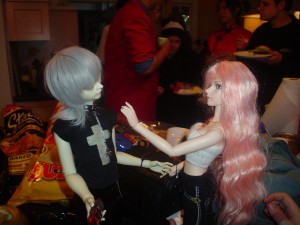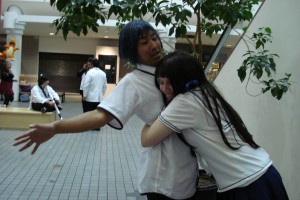Once upon a time in the East Bay, I attended an anime convention dressed up as Super Sailor Mars. The convention was a totally last minute thing. My real life profession took me to the San Francisco Bay Area for a few weeks and there was an anime convention in town. If you know anything about Super Sailor Mars is that she wears a short skirt and red high heels. I won’t lie; I know I have runners legs. I first wore Super Sailor Mars at Anime Expo 2012 and had no issue. However, at this smaller event, I was followed around by a fanboy and asked by a socially awkward male to go up to his hotel room with him. I reported this incident to convention staff and the situation with taken care of. The perpetrator was given a warning and he proceeded to stop following me around the hotel.
I’m very proud that both the cosplay and press community have gathered together to spread the message that cosplay is not consent. I have been around in the convention circuit for the past decade to know that this goes down. I’m also quite surprised that this is not taken up issue until now. For those ten years, we’ve discussed horror stories on cosplay.com and called out creepers by name on /cgl. It’s one thing for all of us to share creeper stories; it’s therapeutic, but it’s another thing to let this slip by. While Cosplay =/= Consent is picking up speed worldwide, it’s time for convention organizers and cosplay gathering coordinators to start asking themselves how to curb creepers and allow attendees to feel safe at cons and gatherings.
Most conventions have an anti-harassment policy. However, some anti-harassment policies are often vague. It’s very commonplace to say, “Report it to security.” Instinctively, this is the first thing to do. Each convention needs to enforce rules and regulations regarding disciplinary action against perpetrators. I have been to Stella Chu’s panel at Katsucon 2013 where the room was brainstorming ideas on how convention staff can curb the creeper problem. I thought, “I hope there’s a convention organizer here to listen to all of this!” These are the types of discussions convention organizers need to be thinking through. Of course, this is no way to end the creeper problem, but consistent discipline and regulations can discourage behavior. It can teach others not to behave in such a way.
Additionally, convention staff also needs to understand that an individual falling back on using a mental disability as an excuse for their actions is no excuse. I have friends who have one form of autism spectrum disorder or another – they know how to live with it. If we keep using mental disabilities an an excuse for behavior (ie: Oh, he has autism / Don’t worry, she has aspergers), it makes people who live with mental disabilities look bad. It’s because of this I’ve known people in the cosplay and lolita community who hold grudges against people with spectrum disorders. This is very unfortunate to the good people who live with mental issues that they are being discriminated against because of actions by the few.
Conventions need to have it clear in the program, the website, and at the con itself that it does not tolerate creepers and that they care about the safety and security of attendees. Conventions should be safe spaces where we celebrate fandom and what we love to do. I would encourage people who feel strongly about this issue to write to the chair of their local convention that they want to see policies against creepers and regulations for keeping attendees safe. If you doubt a convention has a policy against creepers, email or find their Facebook page and ask what to do when reporting a creeper.
Conventions also need to start taking the issue seriously and also discipline staff members (no matter where they are in the hierarchy) for bad behavior. I have no problems with cosplayers naming the names of rude staff members and the convention if they have done nothing to fix a problem. This will only create awareness; it will discourage attendees from supporting the con. No convention wants to see the attendee numbers drop. This is something anime conventions cannot afford right now.
I understand that reporting may not be easy. Sometimes, we’re so caught up in the moment that we’re unsure if we were creeped on. If you aren’t sure, vent to a friend. Together, you can go ahead and report the creeper. By reporting, you prevent other attendees from being creeped on. I do remember a time when I was at a con and a few Panty and Stocking cosplayers were being creeped on, but did not want to report it. It’s always important to report and stick up for yourself – even if you have a friend with you to speak up for you if you’re still in the state of shock.
For fan get togethers outside of conventions – it gets a little tricky. You’re in a public place (ie: park, Little Tokyo, Japan Town, etc). Usually, people will instinctively know who the creepers are. I’ve noticed that Facebook invites have rules and guidelines on people acting out. However, not everyone knows who the creepers are. Deb and I have had to improvise routines to get out of awkward situations with fanboys and fangirls. Certain cosplay get togethers just don’t invite creepers and people who draw negative attention. Discussing on how to deal with creepers at cosplay events in public places is a good thing to start on if it hasn’t been dealt with before. It’s up to us young people to figure out what the best practices are because we’re going to be the ones that are handed over the torch in the new generation of convention organizers.
It’s easy to say, “We should just tell creepers to stop creepin’,” yet I doubt they would read this post. That’s not the world we live in unfortunately. It’s easier to control what you can control. Hence, it’s very important to have these discussions at the top to make conventions a safe space for everyone. We’re far beyond the awareness stage – we’ve been aware that creepers at cons exist for over a decade. Now it’s time for conventions to reshape policy and for cosplay event organizers to learn how to settle creeper issues at their events diplomatically.






